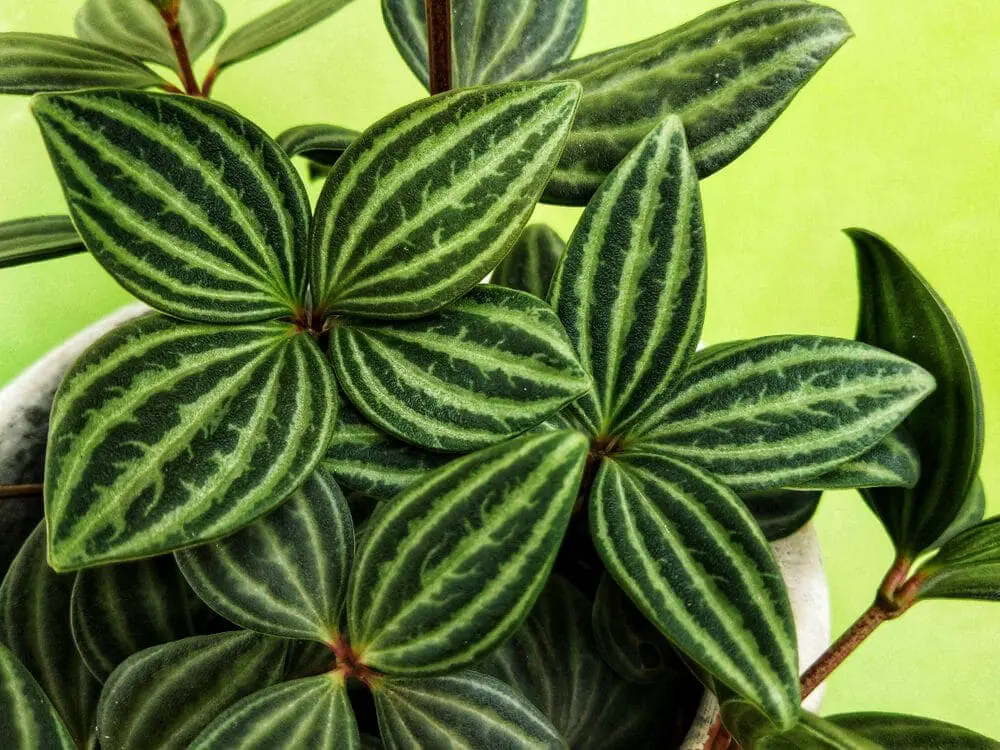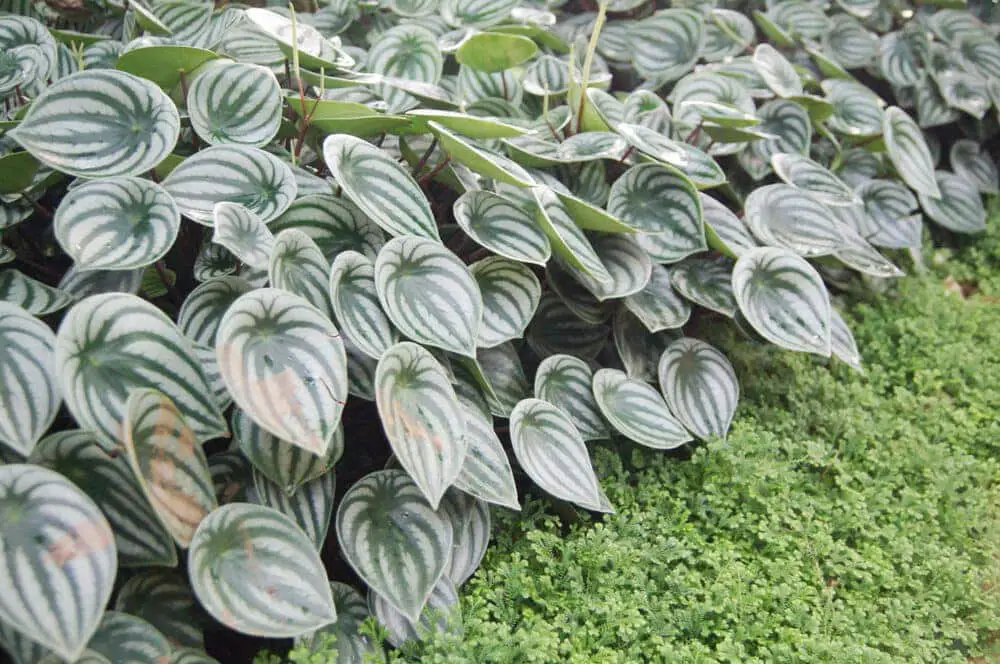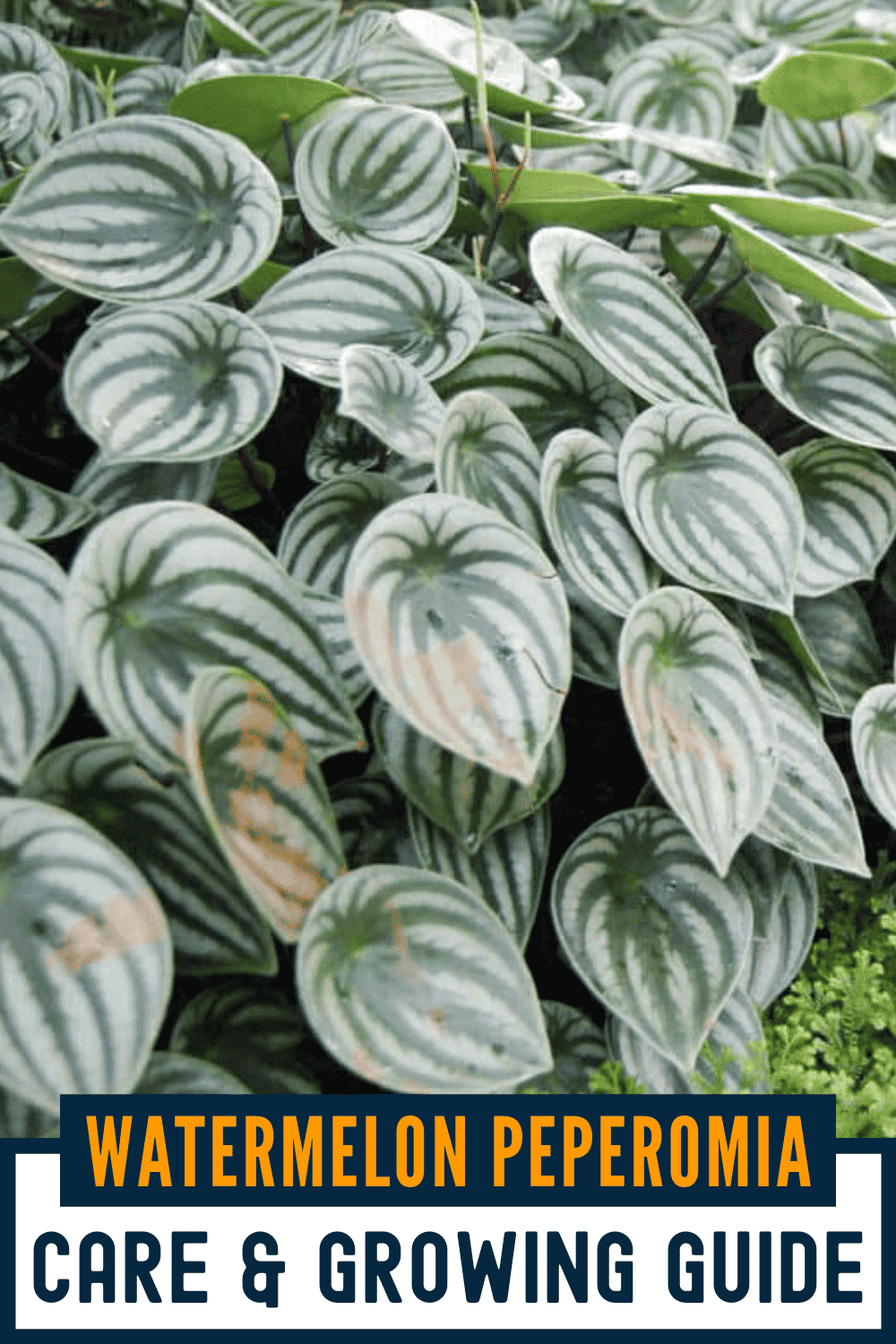If you’re into plants with strange and unusual leaves, then you need to have the watermelon peperomia in your garden.
The design of its large, full leaves looks exactly like a watermelon. Having this plant in your home or garden is sure to make visitors curious and craving watermelon!
Watermelon Peperomia Care & Growing Guide
1. Light Requirement
The watermelon peperomia should not be in direct sunlight. It does best in bright indirect light. If this plant receives too much sun, the sunlight can fade the colors of its leaves.
If this plant is indoors, keep it in a room next to a big full window that away from direct sunlight. If it is outdoors, early morning light is excellent, but by noon this plant should be protected from the sun’s rays.
2. Water
After you water this plant, wait until the top inch of soil is dry to rewater it. Whether it is indoors or outdoors, the soil has to drain freely. Stem rot and root rot are common diseases to this plant, and both occur if the water around the roots is stagnant
Depending on the season, you may have to increase or decrease how often it is water. Outside plants must be watered more often than inside plants, no matter the season.
When the plant has gone too long without enough water, its leaves will droop and look thin.
3. Climate and temperature
The peperomia does not like cold weather. It is a tropical plant that loves humidity. You can set it by a humidifier on its lowest setting, or you can mist it once a day with a spray bottle.
If the plant is outdoors in a pot, bring in the plant when the weather drops below 60 degrees F. If it is in the ground and can’t be moved, then the pepperoni will wither. The best temperature for this plant is around 85 degrees. If the temperature drops below 50 F degrees, the leaves of the peperomia will fall off.
The hardiness zones that this plant can thrive the most in is 10 through 12. 9 might work if it is kept warm.

4. Soil
The roots of the peperomia watermelon need to have access to a lot of room and oxygen. Add perlite to some potting mix to keep the soil from compacting and choking the roots.
The soil for this plant must drain well because if it doesn’t, it will develop stem rot.
Adding fertilizer to the peperomia soil shouldn’t happen too often. It doesn’t need many nutrients, and overfeeding can cause leggy growth. It can be fertilized once a month during the spring and summer. The fertilizer should be water-based and always use too little than too much.
This plant isn’t repotting often, but many gardeners replace the topsoil around this plant once every spring.
5. Repotting
Even as the watermelon peperomia grows, don’t bet on repotting it often. The plant likes its roots to be crowded in the container, so only repot it if they are coming out of the drainage holes.
On average, this plant is repotted once every three years. Repotting needs to be done during the spring.
When you repot the plants, repot like you would any other plants. Make sure the roots are placed gently into the pot and don’t press down and compact the soil when you’re done.
6. Speed of Growth
This plant has a slow growth rate. Because of how slow it grows, it is not recommended to trim it too often. If the peperomia does not receive enough light, it can slow down its already slow growth rate.
7. Height and Spread
Even without intervention or trimming the peperomia usually grows around to be eight inches in height and six inches in length. The amount of light it receives and how frequently it is watered is directly tied to its growth.
8. Trimming
Because this plant grows so slowly, it is not recommended to trim it often. Only prune this plant when it begins to look disorganized and wild. The plant can be trimmed along the stem. Cut off any stems just above the node so that the stem can continue to grow leaves.

Is the Watermelon Peperomia plant poisonous?
No, this plant is not toxic or poisonous to animals or humans. But it is still not recommended to eat it.
Can Watermelon Peperomias Grow in Water?
Yes! Unlike other plants, the watermelon peperomia can be hydroponically grown! Because of their large leaves, they will need a strong growing substitute to prevent it from falling over. It is best to train a baby peperomia to root in water than to switch a fully grow soil-rooted peperomia to water.
Does the Watermelon Peperomia have flowers, and how do I get them to bloom?
Well yes, the watermelon peperomia does have small green flower spikes. But they’re nothing to write home about. The actual feature of this plant is its giant watermelon leaves.
The flowers, when they bloom, are usually brown or yellow, and they have no fragrance.
Also read: Teddy Bear Vine: Plant Care & Growing Guide
Common Watermelon Peperomia Pests and diseases
- Root rot occurs when plant roots have been in stagnant water for too long. It is a fungus that can kill the roots and infect the soil. To fight root rot, if a plant is in the ground, then allow the soil to completely dry before watering it again. Apply fungicide to the soil before its first watering. If it happens to a potted plant, throw away the soil, applied fungicide to the roots, and place it in brand new potting soil.
- Whiteflies are tiny white triangular shaped flies that attack plants by sucking out their nutrients and sap. To fight off whiteflies, wash them away with water through a hose or the sink and then apply an insecticide to keep them away. Cut off all damaged foliage.
More like this:
Conclusion
- This plant is from South America
- Peperomias love the be in humid weather.
- If this plant needs to be fertilized, do it only once a month.
- This plant does have flowers, but they are plain and not much to look at.
- Do not place the peperomia in direct sunlight, or else the sun’s strong rays will fade the coloring of its leaves.
- The hardiness zones this plant does best in is 10 through 12.

Victoria is the owner and main author of hobby plants. She loves spending her free time in her garden planting and taking care of her plants. Victoria hopes you enjoy the content here!
![Queen Of The Night Flower [Complete Plant Care Guide] Queen Of The Night Flower [Complete Plant Care Guide]](https://www.hobbyplants.com/wp-content/uploads/2022/07/queen-of-the-night-flower-300x158.jpg)
![Mother Of Thousands Plant [Complete Plant Care Guide] Mother Of Thousands Plant [Complete Plant Care Guide]](https://www.hobbyplants.com/wp-content/uploads/2022/07/mother-of-thousands-plant-300x158.jpg)
![How Often Should You Water Pothos? [Complete Care Guide] How Often Should You Water Pothos? [Complete Care Guide]](https://www.hobbyplants.com/wp-content/uploads/2022/07/how-often-to-water-pothos-300x158.jpg)
![Can Snake Plants Live Outside? [COMPLETE CARE GUIDE] Can Snake Plants Live Outside? [COMPLETE CARE GUIDE]](https://www.hobbyplants.com/wp-content/uploads/2022/08/can-snake-plants-live-outside-300x158.jpg)
![Majesty Palm Plant Care: [Complete Beginner's Guide] Majesty Palm Plant Care: [Complete Beginner's Guide]](https://www.hobbyplants.com/wp-content/uploads/2022/08/majesty-palm-care-300x158.jpg)
![Exotic Angel Plant Care: [Complete Beginner's Guide] Exotic Angel Plant Care: [Complete Beginner's Guide]](https://www.hobbyplants.com/wp-content/uploads/2022/08/exotic-angel-plant-care-300x158.jpg)
![Do Coleus Like Sun Or Shade: [Complete Care Guide] Do Coleus Like Sun Or Shade: [Complete Care Guide]](https://www.hobbyplants.com/wp-content/uploads/2022/08/coleus-sun-or-shade-300x158.jpg)
![Snow White Waffle Plant: [Complete Care Guide] Snow White Waffle Plant: [Complete Care Guide]](https://www.hobbyplants.com/wp-content/uploads/2022/08/snow-white-waffle-plant-300x158.jpg)
![Waffle Plant Care: [Complete Beginner's Guide] Waffle Plant Care: [Complete Beginner's Guide]](https://www.hobbyplants.com/wp-content/uploads/2022/08/waffle-plant-300x158.jpg)
![Bird Of Paradise Plant Care: [Complete Beginner's Guide] Bird Of Paradise Plant Care: [Complete Beginner's Guide]](https://www.hobbyplants.com/wp-content/uploads/2022/08/bird-of-paradise-plant-300x158.jpg)
![Purple Passion Plant Care: [Complete Beginner's Guide] Purple Passion Plant Care: [Complete Beginner's Guide]](https://www.hobbyplants.com/wp-content/uploads/2022/08/purple-passion-plant-care-300x158.jpg)
![China Doll Plant Care: [Complete Beginner's Guide] China Doll Plant Care: [Complete Beginner's Guide]](https://www.hobbyplants.com/wp-content/uploads/2022/09/china-doll-plant-care-300x158.jpg)